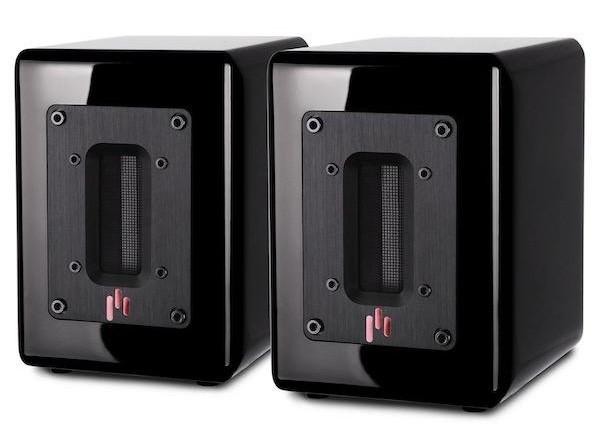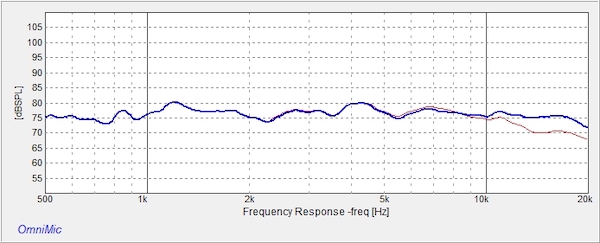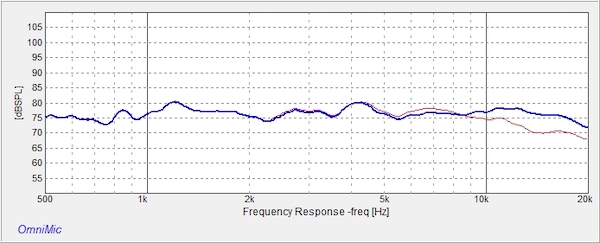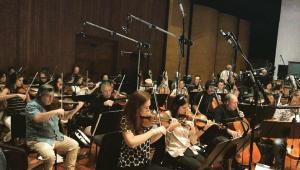Couldn't this exact same effect be realized by simply EQing a few dB shelf above 10kHz? Seems a much more logical method of getting to the same place and wouldn't cost anything...
Hands On: Aperion Audio Super Tweeters

Aperion Audio believes they are. They offer three different super tweeters as add-on devices to your current loudspeakers. There are other super tweeters on the market, but as a category they're rare. Aperion sent me one of each — the pure Aluminum Ribbon at $649 (shown in the photo above), the Planar-Ribbon at $399, and the pure Dual Aluminum Ribbon (radiating toward both the front and the back) at $999.
This evaluation has been long delayed (my bad) so the first two models are now MK II versions while my samples are all Mk ls. But apart from some cabinet and rear panel changes in the Aluminum Ribbon model (replacing the original jumper gain adjustments with a switch) and some price changes, as far as I could determine the Mk IIs are technically unchanged. Aperion also offers two sets of silver cables (a $50 option) to make the connection between their tweets and the terminals on your main speakers, though you could fabricate your own or perhaps find them from another source. I used the Aperion cables for this report, but they're very stiff and tend to visibly splay out from behind your speakers unless you somehow secure them to the back of the main speaker cabinet; tape might be the best solution for this to avoid marring your speakers. The cables were also barely long enough to run from the super tweets to the rear terminals on the Monitor Audio Silver 10 speakers I used here.
The rear of each model offers several crossover frequency and gain settings. But the gain of the super tweeters can only be reduced as they are passive devices. This might not result in a good match with loudspeakers of higher than average efficiency, such as some Klipsch and JBL designs. In that case these super tweeters won't be a viable option. Fortunately, such a mismatch is likely to be rare, and Aperion offers a 30-day return-trial and refund if you're unhappy with them for any reason. Also note that if your current speakers have a tweeter mounted significantly lower than the top of the cabinet, a top-mounted super tweeter might not make for a good match.
A super tweeter is not directly analogous to a subwoofer, even apart from it operating at the other end of the frequency spectrum. A subwoofer is far more likely to make an obvious, audible change in your listening life than a super tweeter unless your main speakers are unusually soft in the treble. The latter describes some otherwise fine speakers for which a super tweeter might just fit the bill, though this will certainly change the main speaker's intended design goal. Nevertheless, I found that when properly adjusted via trial and error (or, as I did, by measurements—a far faster route to proper setup than listening tests) the super tweeters did enhance the openness and air even on the inherently good top end of my Monitor Audio speakers. But if your main speakers are unusually bright, a super tweeter is unlikely to help; that brightness might swamp any advantage a super tweeter can offer.
In my setup I positioned each super tweeter (in turn) atop the main speakers and set back about a quarter-inch from the front baffle. I also tilted the tweeters slightly forward, though the need for this will depend on the height of your main speakers and listening seat. But be careful with this; you don't want a tweeter falling off and damaging itself and/or your main speakers! Regardless of whether you tilt the tweeters or not, if you live in earthquake country I also strongly recommend using museum putty (such as Blu-Tac or an equivalent) to secure them into place. That's important even with the relatively heavy Aluminum Ribbon and Dual Ribbon models, but perhaps even more so with the much lighter Planar-Ribbons that might dance around on their own when triggered by vibrations in the main speaker cabinet.
The Aluminum Ribbon and Planar-Ribbon were very similar sonically. The latter is of the Air Motion Transformer (AMT) variety, often used today as the main tweeter in some full range speakers. Technically an AMT isn't a true ribbon. Regardless, both Aperion models provided a subtle but audible enhancement to the sound (perhaps more than subtle if you're under 30 and don't listen to headphones at crushing volume levels, work in a steel mill, or attend frequent rock concerts without ear protection!). The average listener may shrug his or her shoulders at the result, but the picky audiophile (and if you've read this far that could be you) might well appreciate what a super tweeter can do with the right main speakers.
I found that both models produced a subtle enhancement in air and openness. It wasn't wow-inducing in the way that a great subwoofer can upend your audio expectations, but I definitely liked what I heard. The true Aluminum Ribbon came out on top by a nose for me, offering a slightly silkier texture on the right source material (though it took a lot of A/B listening to sort this out). Is it worth its higher price? That's up to you. But you could always order both (if your budget will withstand a temporarily higher hit) and keep the one you prefer. (Aperion will definitely hate me for suggesting that!).
I wasn't a big fan of the pricier dual ribbon model. By measurement it actually began rolling off closer to 15kHz than to the 20kHz plus of the other two. But few of us are likely to be very sensitive above 15kHz, and there's not a lot of source material that goes significantly higher (sorry, high-res fans). Nor did its rear-reflection capability add any audible benefits for me. But that might be different in another setup in a different room.
One issue I did find, particularly on the Aluminum Ribbon, is that the tweeters weren't all that well matched. Each required different crossover and level settings for identical measurements. (I did swap them left and right to ensure that the measured differences weren't room or position related; they weren't.) This suggests that the ribbons themselves might not be tightly matched. The different settings available did ultimately result in a good match, however, and even in the same settings, without the benefit of measurement-matching, the differences were unlikely to be audibly obvious.
Both figures below are for the left channel only, taken with the Parts Express Omnimic measuring system at a single point in the main listening seat, using the flattest gain and frequency adjustments in the given setup and 1/12 octave smoothed. Fig.1 (top) is for the Aluminum Ribbon and Fig.2 (bottom) for the Planar-Ribbon.


- Log in or register to post comments


Not to say anything about the quality of the treble these tweeters supply, but, if your speakers are so lame as to need super tweeters, there is something seriously wrong with your speakers.
When I bought my first real audio system in 1976, most speakers didn't have great tweeters so these would be a great add-on.
Almost 50 years later, though, even cheap speakers have pretty good treble now in all aspects.
I agree with the previous post: turn the treble EQ up a bit. Unless you are a canine, this product has no value. Also, it doesn't hurt for your speakers to have treble response that reaches beyond 25kHz, but you can't hear that even if you are 10 years old.
Rather than buying super tweeters, save up and buy better speakers.

Here's how long I've been following audio. As a college freshman I had a friend who owned AR-3 speakers, which had great bass extension but were a touch reticent in the treble department, to say the least. He went to Radio Shack and bought a pair of add-on electrostatic tweeters rated out to bat-squeak range. Did they make a difference? Oh yes -- very impressive. Was the result more balanced and natural as well as more extended? Back in those days I thought so. Today, however, with all the design and testing resources available to speaker companies, there's no reason why a speaker should need add-on tweeter to sound good.

I well remember "The Shack". I was a boy for whom Allied Radio was my personal "WISH BOOK". I had a bad feeling when Allied was no longer and in it's stead was now Allied-Radio Shack (later simply Radio Shack). My foreboding feeling of doom took a lot longer to fully take hold, but it did. I mean who wouldn't rather shop at a store that sold their own brand but also JBL, Altec, University, Bozak, Fisher, Sansui, Sony, and more. Allied was the best in it's day. OK, I digress. This is about RS selling electrostatic add-ons. While it wouldn't really surprise me (RS would try anything), I think RS famous add-on super tweeter was a solid state piezo job. Piezos are pretty maligned it's true. But at the extreme at low volume through a plastic diffuser/horn...why not? Unrefined did not matter at such low relative volume. It just was hinting at "air" more than anything. I don't pretend to know, but for my life I can't remember RS add-on electrostatic tweeters.

When Aperion was a new company I think it was named something else. Does anyone know what that might have been?

No wonder this product is a big failure for Aperion. They are on sale now. But see no use for these unless someone has old speakers that are soft in treble. My Monitor Audio RX6 as such have enough treble and I apply a 1db treble cut in the receiver to tame it. My other set Mirage OMD15s too don’t need any more treble.































































